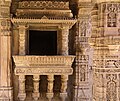Adalaj stepwell
The Adalaj Stepwell ( Gujarati અડાલજની વાવ Adalaj Waw ) in the Indian state of Gujarat is one of the largest and most beautiful of its kind.
location
The stepwell is located on the northwestern edge of the small town of Adalaj at an altitude of 70 m , about 19 km (driving distance) north of Ahmedabad .
Legend
According to local tradition, the Hindu prince Rana Veer Singh from the Vaghela dynasty ruled the region towards the end of the 15th century . However, its territory was attacked by Mahmud Begada , the Muslim ruler over large parts of the country - Rana Veer Singh was killed in the dispute . His beautiful young widow, Rani Rudabai , agreed to marry Mahmud Begada on condition that the well construction started by her first husband in Adalaj would be completed, which according to an inscription happened in 1499. While Mahmud Begada (r. 1458–1511) is historically documented as the most important Sultan of Gujarat, the other people have more legendary traits.
architecture
With its length of approx. 75 m and a width of approx. 15 m, the Adalaj stepwell is one of the largest structures of its kind. It is built in a north-south direction; At its northern end is the approximately 20 m deep octagonal well, which is divided into several storeys and to which a staircase with several platforms leads down from the south. In the monsoon season (approx. July to October) the entire well system filled with water, which the women could now draw at different levels every day without great effort. Noteworthy are some sitting areas with balconies ( jharokhas ) , which allowed visitors (mostly women) to rest and chat for a while in the cool atmosphere of the fountain.
ornamentation
The walls of the stepwell, but above all the pillars and columns of the various platforms are decorated in great detail - nevertheless, the lack of figures of gods and living beings is immediately apparent, which indicates that the fountain was created or completed in the Islamic period. Typical Hindu ornamentation includes multi-tiered pillars with jug motifs ( kalashas ) and strongly stylized overflowing foliage, full or fan rosettes , garlands and bells hanging from chains. The few figurative motifs include elephants and leogryphs ( vyalas ) , which are often seen at Hindu temples. The entire rich ornamentation corresponds more to that of an Indian sacred building than that of a functional building and in fact numerous fountains and temple ponds in India enjoyed a quasi-religious veneration.
See also
- Rani Ki Vav , Patan , Gujarat
literature
- Jutta Jain Neubauer: The Stepwells of Gujarat. An Art-historical Perspective. Abhinav Publications, 1981, ISBN 0-391-02284-9 .
- Morna Livingston, Milo Beach: Steps to Water. The Ancient Stepwells of India. Princeton Architectural Press, 2002, ISBN 1-56898-324-7 .
Web links
Coordinates: 23 ° 10 ′ 2 ″ N , 72 ° 34 ′ 48 ″ E






